
The Opiliones are an order of arachnids colloquially known as harvestmen, harvesters, or daddy longlegs. As of April 2017, over 6,650 species of harvestmen have been discovered worldwide, although the total number of extant species may exceed 10,000. The order Opiliones includes five suborders: Cyphophthalmi, Eupnoi, Dyspnoi, Laniatores, and Tetrophthalmi, which were named in 2014.

The order Ricinulei is a group of arachnids known as hooded tickspiders, though they are not true spiders. Like most arachnids, they are predatory, eating small arthropods. In older works they are sometimes referred to as Podogona.
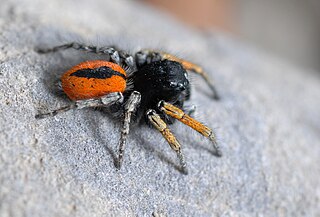
Philaeus chrysops is a species of jumping spider (Salticidae).

Ogoveidae is a family of harvestmen with three described species in one genus, Ogovea, which is found in equatorial West Africa.

The Neogoveidae are a family of harvestmen with 27 described species in eight genera. However, eight species of Huitaca, 17 species of Metagovea and 12 species of Neogovea are currently awaiting description.

Nipponopsalididae is a family of harvestmen with three described species in one genus, Nipponopsalis, which is found in East Asia.
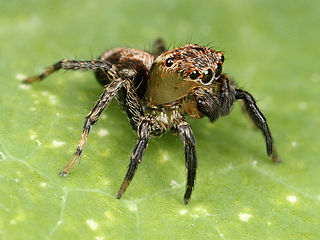
Salticinae is a subfamily of jumping spiders. It includes over 90% of the known species of jumping spiders. The subfamily is divided into two unranked clades: Amycoida and Salticoida.
Assamiidae are a family of harvestmen with more than 400 described species. It is the third most diverse family of the suborder Laniatores.

Opiliones are an order of arachnids and share many common characteristics with other arachnids. However, several differences separate harvestmen from other arachnid orders such as spiders. The bodies of opiliones are divided into two tagmata : the abdomen (opisthosoma) and the cephalothorax (prosoma). Unlike spiders, the juncture between the abdomen and cephalothorax is often poorly defined. Harvestmen have chelicerae, pedipalps and four pairs of legs. Most harvestmen have two eyes, although there are eyeless species.
Italy has the highest level of faunal biodiversity in Europe, with over 57,000 species recorded, representing more than a third of all European fauna. This is due to various factors. The Italian peninsula is in the center of the Mediterranean Sea, forming a corridor between central Europe and North Africa, and it has 8,000 km of coastline. Italy also receives species from the Balkans, Eurasia, and the Middle East. Italy's varied geological structure, including the Alps and the Apennines, Central Italian woodlands, and Southern Italian Garigue and Maquis shrubland, also contribute to high climate and habitat diversity.
Vittore Ghiliani, was an Italian entomologist From 1832 until his death he worked as an Assistant (Curator) in the Zoological Museum of Turin where he was responsible for the Hymenoptera and Coleoptera collections of Maximilian Spinola and the Ferdinando Breme collection of Coleoptera and Diptera. Vittore Ghiliani was an "Adviser" of the Italian Entomological Society from 1869 to 1871 and Vice-President from 1871 until 1878. He published a series of scientific papers on the Coleoptera of Sardinia, Sicily, Spain and Brasil and edited by Lorenzo Camerano an important list of species of Coleoptera from Piedmont. In Compte rendu des hyménoptères inédits provenants du voyage entokologique de M. Ghiliani dans le Para en 1846. Memoire della Reale Accademia della Scienze di Torino (2)13: 19–94 Spinola comments that M. Ghiliani in 1846 embarked to Brazil where he remained for three years,having disembarked in Belém, collecting insects of all the orders.
This glossary describes the terms used in formal descriptions of spiders; where applicable these terms are used in describing other arachnids.
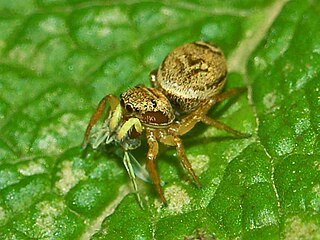
Heliophanus tribulosus is a species of 'jumping spiders' belonging to the family Salticidae.

Scelophysa trimeni, commonly known as the blue monkey beetle, is a species of scarab beetles in the monkey beetle subfamily Rutelinae.
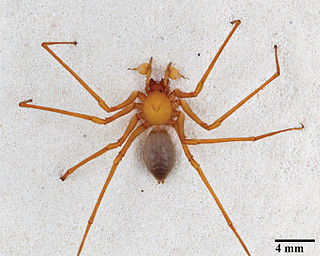
Trogloraptor is a genus of large spiders found in the caves of southwestern Oregon. It is the sole genus in the family Trogloraptoridae, and includes only one species, Trogloraptor marchingtoni. These spiders are predominantly yellow-brown in color with a maximum leg span of 3 in (7.6 cm). They are remarkable for having hook-like claws on the raptorial last segments of their legs.
Emilio Berio was an Italian entomologist and lawyer.

Metaphalangium cirtanum is a species of harvestman belonging to the family Phalangiidae.

Nelima doriae is a species of harvestman in the family Sclerosomatidae.
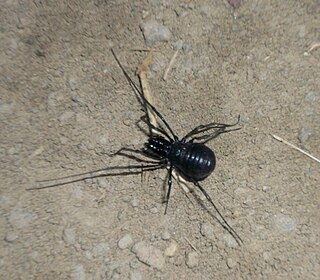
Ischyropsalis is a genus of harvestmen in the family Ischyropsalididae, found in Europe. There are more than 20 described species in Ischyropsalis.
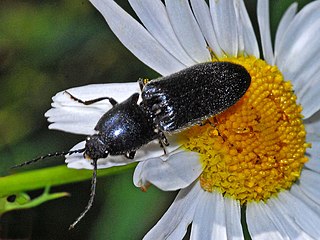
Megathous nigerrimus is a species of click beetles in the family Elateridae.














